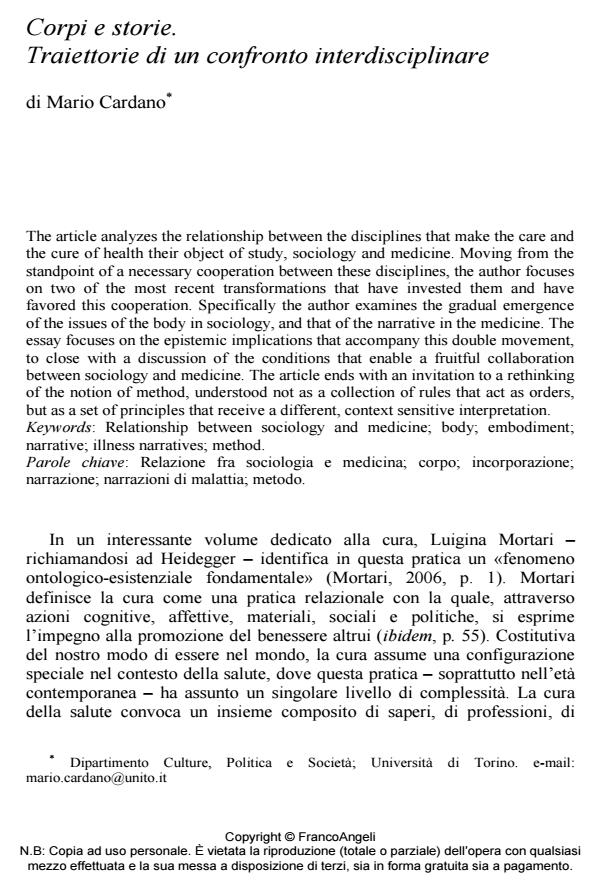Corpi e storie. Traiettorie di un confronto interdisciplinare
Titolo Rivista SALUTE E SOCIETÀ
Autori/Curatori Mario Cardano
Anno di pubblicazione 2015 Fascicolo 2015/3 Lingua Italiano
Numero pagine 10 P. 34-43 Dimensione file 372 KB
DOI 10.3280/SES2015-003004
Il DOI è il codice a barre della proprietà intellettuale: per saperne di più
clicca qui
Qui sotto puoi vedere in anteprima la prima pagina di questo articolo.
Se questo articolo ti interessa, lo puoi acquistare (e scaricare in formato pdf) seguendo le facili indicazioni per acquistare il download credit. Acquista Download Credits per scaricare questo Articolo in formato PDF

FrancoAngeli è membro della Publishers International Linking Association, Inc (PILA)associazione indipendente e non profit per facilitare (attraverso i servizi tecnologici implementati da CrossRef.org) l’accesso degli studiosi ai contenuti digitali nelle pubblicazioni professionali e scientifiche
The article analyzes the relationship between the disciplines that make the care and the cure of health their object of study, sociology and medicine. Moving from the standpoint of a necessary cooperation between these disciplines, the author focuses on two of the most recent transformations that have invested them and have favored this cooperation. Specifically the author examines the gradual emergence of the issues of the body in sociology, and that of the narrative in the medicine. The essay focuses on the epistemic implications that accompany this double movement, to close with a discussion of the conditions that enable a fruitful collaboration between sociology and medicine. The article ends with an invitation to a rethinking of the notion of method, understood not as a collection of rules that act as orders, but as a set of principles that receive a different, context sensitive interpretation.;
Keywords:Relazione fra sociologia e medicina; corpo; incorporazione; narrazione; narrazioni di malattia; metodo.
- Parson T. (1977). La relazione medico paziente. In: Maccacaro G.A., Martinelli A., a cura di, Sociologia della medicina. Milano: Feltrinelli: 183-214
- Pope C., Mays N. (2000). Qualitative Research in Health Care. London: BMJ Book
- Black M. (1962). Models and metaphors. Ithaca-New York: Cornell University Press (trad. it.: Modelli Archetipi Metafore. Parma: Pratiche, 1983)
- Blumer H. (1969). Symbolic Interactionism. Englewood Cliffs: N.J., Prentice Hall
- Bruner J.S. (1986). Actual Minds, Possible Worlds. Cambridge, MA: Harvard University Press (trad. it.: La mente a più dimensioni. Roma-Bari: Laterza, 2003)
- Bury M. (1982). Chronic Illness as biographical disruption. Sociology of Health and Illness, Vol. 2: 167-182
- Cardano M. (2008). Disuguaglianze sociali di salute. Differenze biografiche incise nei corpi. Polis, a. XXII, n. 1: 119-146
- Cardano M. (2011). La ricerca qualitativa. Bologna: il Mulino
- Cardano M., Palumbo P., Di Nicola P., Secondulfo D. (2011). Stratificazione sociale, classi sociali e diseguaglianze di salute. Salute e Società, a. X, n. 3: 155-169
- Charon R. (2006). Narrative Medicine. Honoring the Stories of Illness. Oxford: Oxford University Press
- Feuer M.J., Towne L., Shavelson R.J. (2002). Scientific Culture and Educational Research. Educational Researcher, Vol. 31, n. 8: 4-14
- Frank A. (1995). The Wounded Storyteller. Body, illness and ethics. Chicago: University of Chicago Press
- Freidson E. (1960). Client Control and Medical Practice. American Journal of Sociology, 65: 374-382 (trad.it.: Il controllo del cliente e la pratica professionale del medico. In: Maccacaro G.A., Martinelli A., a cura di, Sociologia della medicina. Milano: Feltrinelli: 227-238, 1977)
- Freidson E. (2002). La dominanza medica. Le basi sociali della malattia e delle istituzioni sanitarie. Milano: Franco Angeli Gallino L. (1992). L’incerta alleanza. Modelli di relazioni tra scienze umane e scienze naturali. Torino: Einaudi
- Giarelli G., Good B.J., Del Vecchio Good M., Martini M., Ruozi C. (2005). Medicina narrativa e medicina delle evidenze: l’integrazione possibile. Milano: Franco Angeli
- Hesse M. (1966). Models and Analogies in Science. Notre Dame: The University of Notre Dame Press (trad. it.: Modelli e analogie nella scienza. Milano: Feltrinelli, 1980)
- Hunter K.M., Charon R., Coulchan (1995). The Study of Literature in Medical Education. Academic Medicine, Vol. 70, n. 9: 787-794
- Jurecic A. (2012). Illness as narrative. Pittsburgh: University of Pittsburgh Press
- Kinsman G. (1996). “Responsability” as a strategy of governance: regulating people living with AIDS and lesbian and gay men in Ontario. Economy and Society, vol. 25, n. 3: 393-409
- Kleinman A. (1988). The Illness Narratives. Suffering, Healing and the Human Condition. New York: Basic Books
- Latour B. (2004). Why Has Critique Run out of Steam? From Matters of Fact to Matters of Concern. Critical Inquiry, vol. 30: 225-248
- Madison G.B. (1988). The hermeneutics of postmodernity. Bloomington: Indiana University Press
- Marmot M. (2004). Status Syndrome. How your social standing direcly affects your health. Londra: Bloomsbury Publishing
- Mortari L. (2006). La pratica dell’aver cura. Milano: Bruno Mondadori
- Parsons T. (1951). The Social System. Glencoe: The Free Press. (trad. it. Il Sistema Sociale. Milano: Edizione di Comunità, 1965)
- Shilling C. (2003). The Body and Social Theory. Second edition. London: Sage.
- Townsend P., Davidson N. (1982). Inequalities in Health: The Black Report. Harmondsworth: Penguin Books
- Turner B. (2004). The New Medical Sociology. Social Forms of Health and Illness. New York: W. W. Norton Company Inc
Mario Cardano, Corpi e storie. Traiettorie di un confronto interdisciplinare in "SALUTE E SOCIETÀ" 3/2015, pp 34-43, DOI: 10.3280/SES2015-003004